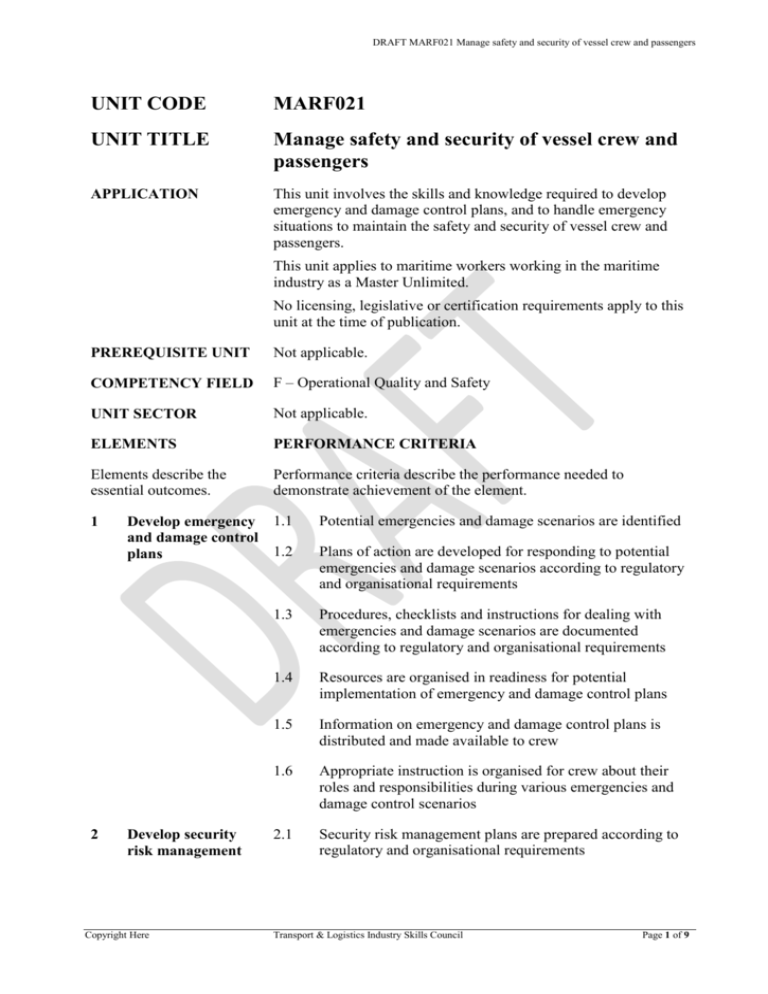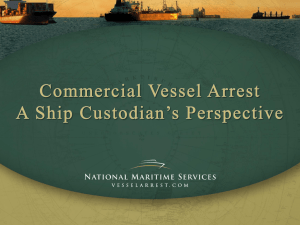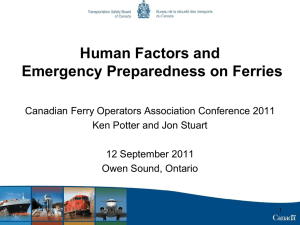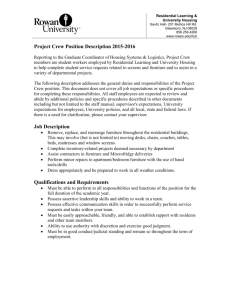APPENDIX ONE
advertisement

DRAFT MARF021 Manage safety and security of vessel crew and passengers UNIT CODE MARF021 UNIT TITLE Manage safety and security of vessel crew and passengers APPLICATION This unit involves the skills and knowledge required to develop emergency and damage control plans, and to handle emergency situations to maintain the safety and security of vessel crew and passengers. This unit applies to maritime workers working in the maritime industry as a Master Unlimited. No licensing, legislative or certification requirements apply to this unit at the time of publication. PREREQUISITE UNIT Not applicable. COMPETENCY FIELD F – Operational Quality and Safety UNIT SECTOR Not applicable. ELEMENTS PERFORMANCE CRITERIA Elements describe the essential outcomes. Performance criteria describe the performance needed to demonstrate achievement of the element. 1 2 Develop emergency 1.1 and damage control 1.2 plans Develop security risk management © Copyright Here Potential emergencies and damage scenarios are identified Plans of action are developed for responding to potential emergencies and damage scenarios according to regulatory and organisational requirements 1.3 Procedures, checklists and instructions for dealing with emergencies and damage scenarios are documented according to regulatory and organisational requirements 1.4 Resources are organised in readiness for potential implementation of emergency and damage control plans 1.5 Information on emergency and damage control plans is distributed and made available to crew 1.6 Appropriate instruction is organised for crew about their roles and responsibilities during various emergencies and damage control scenarios 2.1 Security risk management plans are prepared according to regulatory and organisational requirements Transport & Logistics Industry Skills Council Page 1 of 9 DRAFT MARF021 Manage safety and security of vessel crew and passengers plans 3 4 5 Maintain the operational condition of firefighting, lifesaving and safety systems Organise fire and abandon vessel drills Manage emergencies Page 2 of 9 2.2 Explanatory information on the importance of security and the organisation’s security objectives is contained in plans 2.3 Threat assessments undertaken, current exposure and current protective security arrangements are summarised in plans 2.4 Security strategies for implementing, monitoring and evaluating countermeasures are outlined in plans 2.5 Appropriate instruction is organised for crew about their roles and responsibilities in a security threat 3.1 Safety management system (SMS) processes and outcomes for maintaining the operational condition of firefighting, lifesaving and safety systems are identified 3.2 Procedures and supporting documentation for the routine maintenance of firefighting, lifesaving and safety systems are developed DRAFT 3.3 Personnel roles and responsibilities are allocated and communicated 3.4 Checks are conducted according to SMS requirements 3.5 Non-compliances are identified and analysed 3.6 Appropriate responses to non-compliances are initiated according to SMS requirements 3.7 Outcomes are recorded and reported according to regulatory and organisational requirements 4.1 Fire and abandon vessel drills are planned and conducted according to regulatory requirements and organisational procedures 4.2 Instruction is provided to others on organisational procedures and the correct use of firefighting and lifesaving equipment 4.3 Musters and drills are reviewed against objectives 4.4 Records are completed according to regulatory requirements and organisational procedures 5.1 Initial actions on becoming aware of emergency are undertaken according to contingency plans, urgency of the situation and nature of the emergency Transport & Logistics Industry Skills Council Copyright Here DRAFT MARF021 Manage safety and security of vessel crew and passengers 6 7 Maintain operational safety Respond to security risks 5.2 On-board personnel are given information and instructions clearly and accurately 5.3 Procedures are implemented to combat emergency and to protect persons on board 5.4 Communications are established with others to facilitate the emergency response process 5.5 Assistance is coordinated and provided by appropriate personnel 5.6 Contact is maintained with others at all times to keep them briefed on the emergency response process 5.7 Preparation for abandoning vessel is undertaken, if required 5.8 Cessation of emergency is communicated to appropriate personnel 6.1 Environmental factors are continually monitored, assessed and reviewed to identify distinctive features and any change in characteristics that might indicate unusual or suspicious behaviour 6.2 Personal safety checks are made on a systematic and routine basis according to organisational procedures 6.3 Resources and equipment are organised in readiness for potential security risk situations 7.1 Security risk situations are accurately identified and assessed for degree of risk to self, others and vessel 7.2 Response to security risk is formulated and carried out according to security risk management plan 7.3 Safety and security of self, others and vessel is maximised through response initiative 7.4 Changing circumstances are monitored and responses are adjusted as required to maintain security 7.5 Relevant documentation is completed and securely maintained according to confidentiality requirements and organisational procedures FOUNDATION SKILLS Foundation skills essential to performance are explicit in the performance criteria of this unit of © Copyright Here Transport & Logistics Industry Skills Council Page 3 of 9 DRAFT MARF021 Manage safety and security of vessel crew and passengers competency. RANGE OF CONDITIONS Range is restricted to essential operating conditions and any other variables essential to the work environment. Potential emergencies include one or more of the following: Information includes one or more of the following: accidents bomb threat collision fire or explosion flooding grounding loss of main engine or power loss of steering person overboard rescue and evacuation of injured persons scenes of crime documented instructions drills meetings notice boards pamphlets training sessions Threat assessments include one or more of the following: Exposure includes: determining the potential of a threat to actually cause harm evaluating and discussing the likelihood of a threat being realised providing information about people and events that may pose a threat to the crew, passengers and/or the vessel measure of how open the vessel is to harm potential of the vessel to attract harm Firefighting, lifesaving and safety systems include one or more of the following: Page 4 of 9 DRAFT fire and smoke detectors and alarms fire and watertight doors fire hoses and extinguishers fire smothering systems Transport & Logistics Industry Skills Council Copyright Here DRAFT MARF021 Manage safety and security of vessel crew and passengers Non-compliances include one or more of the following: Initial actions include one or more of the following: Environmental factors include one or more of the following: Resources and equipment include one or more of the following: Security risk situations include one or more of the following: © Copyright Here flares and smoke floats lifeboats and life rafts life jackets and other flotation devices damaged components damaged equipment failure to conduct drills faulty components faulty equipment lapsed expiry dates levels of consumable materials quality of consumable materials broadcasting appropriate distress or warning signals calling crew and passengers to muster stations investigating the source of fire or smoke alarms mustering appropriate resources access to assistance and resources availability of opportunities for escape degrees of illumination in affected areas presence of sources of threat time of day weather access to emergency services and specialist personnel back-up personnel communication equipment firefighting equipment first aid kit personal protection equipment security equipment including electronic screening equipment, video cameras and monitors, alarms and signals breaches of law including criminal damage, offences against people, public order, misuse of drugs and alcohol emergencies hazards including physical, chemical, electrical, psychological, Transport & Logistics Industry Skills Council Page 5 of 9 DRAFT MARF021 Manage safety and security of vessel crew and passengers biological Responses to security risk include one or more of the following: threats including bombs, sabotage, assassination abandoning the vessel checking identification defusing the situation isolating area of potential risk isolating risk issuing verbal warnings notifying relevant emergency services organisations offering assistance providing first aid requesting support and assistance restraint of person tactical withdrawal using basic defensive techniques using negotiation techniques DRAFT UNIT MAPPING INFORMATION This unit replaces and is equivalent to MARF6003A Manage safety and security of vessel crew and passengers. LINKS MAR Maritime Training Package Companion Volume Implementation Guide at: http://tlisc.org.au/trainingpackages/maritime-training/. Page 6 of 9 Transport & Logistics Industry Skills Council Copyright Here DRAFT MARF021 Manage safety and security of vessel crew and passengers TITLE Assessment Requirements for MARF021 Manage safety and security of vessel crew and passengers PERFORMANCE EVIDENCE Evidence required to demonstrate competence in this unit must be relevant to and satisfy all of the requirements of the elements, performance criteria and range of conditions on at least one occasion and include: KNOWLEDGE © Copyright Here applying all relevant work health and safety (WHS)/occupational health and safety (OHS) and work practices applying procedures for monitoring fire detection and safety systems to ensure all alarms are detected promptly and acted upon according to established emergency procedures communicating using appropriate channels and communication codes and signals completing documentation and reporting requirements on matters related to the development of emergency and damage control plans determining response appropriate to security risk situations developing emergency procedures according to established plans for emergency situations developing effective planning documents identifying and complying with security incident response procedures identifying security risk factors and conducting risk assessments instructing personnel on procedures to be taken during emergency situations on board a vessel interpreting and applying security and safety practices and regulations maintaining the operational condition of lifesaving, firefighting and other safety systems managing the handling of emergency situations on board a vessel minimising hazards and risks to the safety of self and others organising fire drills and abandon ship drills preparing contingency plans for response to emergencies providing the required amount of detail in reports reporting emergency situations on board a vessel. Evidence required to demonstrate competence in this unit must be Transport & Logistics Industry Skills Council Page 7 of 9 DRAFT MARF021 Manage safety and security of vessel crew and passengers EVIDENCE Page 8 of 9 relevant to and satisfy all of the requirements of the elements, performance criteria and range of conditions and include knowledge of: actions to be taken to protect and safeguard all persons on board in emergencies actions to limit damage and save the vessel following fire, collision or grounding bomb threat and counter-terrorism procedures concept of reserve buoyancy and its relevance to damage control in vessels faults that can occur with fire detection, firefighting, lifesaving and safety equipment, and systems and appropriate remedial action and solutions functions and use of lifesaving appliances general principles of damage control and the manner in which the watertight integrity of the hull is maintained on a vessel importance of maintaining fire detection, firefighting, lifesaving and safety equipment and systems, and potential consequences if the equipment or systems are not operational during an emergency lifesaving appliance regulations (International Convention for the Safety of Life at Sea) methods and aids for fire prevention, detection and extinction methods for checking and replacing consumable materials in fire detection, firefighting, lifesaving and safety equipment and systems regulations related to security risk management regulatory requirements for emergency response plans regulatory requirements related to maintaining fire detection, firefighting, lifesaving and safety equipment and systems relevant Australian Maritime Safety Authority (AMSA) Marine Orders and Notices, International Ship and Port Facility Security Code (ISPS Code), and other relevant International Maritime Organization (IMO) Conventions and Codes safety management system (SMS) plans, procedures, checklists and instructions ship construction including damage control measures statutory requirements pertaining to damage control in vessels types of fire detection, firefighting, lifesaving and safety DRAFT Transport & Logistics Industry Skills Council Copyright Here DRAFT MARF021 Manage safety and security of vessel crew and passengers equipment and systems on board vessels and the procedures for their use ASSESSMENT CONDITIONS ways of controlling damage during a flooding emergency WHS/OHS requirements and work practices. As a minimum, assessors must satisfy applicable regulatory requirements, which include requirements in the Standards for Registered Training Organisations, current at the time of assessment. As a minimum, assessment must satisfy applicable regulatory requirements, which include requirements in the Standards for Registered Training Organisations, current at the time of assessment. Assessment processes and techniques must be appropriate to the language, literacy and numeracy requirements of the work being performed and the needs of the candidate. Assessment must occur in workplace operational situations or where this is not available, in simulated workplace operational situations or an industry-approved marine operations site where a range of damage scenarios can be demonstrated including: collision damage damage caused by cargo shift integrity of vessel hull. Resources for assessment include access to: relevant documentation including workplace procedures, activity logs, incident reports, request for assistance forms, records of conversations, regulations, codes of practice and operation manuals tools, equipment, material and personal protective equipment currently used in industry. Performance should be demonstrated consistently over time and in a suitable range of contexts. LINKS © Copyright Here MAR Maritime Training Package Companion Volume Implementation Guide at: http://tlisc.org.au/trainingpackages/maritime-training/. Transport & Logistics Industry Skills Council Page 9 of 9






